Vape pens, perceived as less harmful than traditional smoke, indeed carry significant consequences for lung health. The battery-operated devices heat liquids containing damaging substances such as nicotine and diacetyl that, when inhaled as an aerosol, can cause severe lung damage and respiratory conditions. Short-term effects include inflammation and respiratory issues, while long-term use exposes users to irreversible lung damage, diseases like ‘popcorn lung,’ and even lung cancer. Notably, the allure of vaping, particularly among youth, makes understanding its actual impact on lung health more urgent. Unraveling further details might illuminate a more straightforward path to prevention.
Key Takeaways
- Vaping exposes the lungs to harmful substances like nicotine, diacetyl, and heavy metals, potentially causing lung damage and respiratory issues.
- Prolonged vaping can lead to significant lung conditions such as bronchiolitis obliterans, lung cancer, and the severe lung disease EVALI.
- Vape pens deeply penetrate the lungs, leading to inflammation, lung scarring, breathing difficulties, and even collapsed lungs in severe cases.
- Flavored vape juices, often marketed to younger users, can cause lung damage and establish early nicotine addiction, leading to potential long-term respiratory diseases.
- Vaping, though often perceived as safer than traditional smoking, has been linked to severe lung health implications, debunking the myth of its relative safety.
Understanding the Vaping Trend

While vaping, a process that involves inhaling aerosol from a device that heats liquid instead of burning tobacco, has become increasingly popular, it is essential to understand its implications. This trend, primarily observed among the youth, has been fueled by the perception of e-cigarettes and vape pens as less harmful alternatives to traditional cigarettes. However, emerging evidence suggests that the effects of vape pens on the lungs could be detrimental.
Vaping devices, including vape pens, produce an aerosol by heating a liquid containing nicotine, flavoring agents, and an oily base. This aerosol is then inhaled into the lungs. One of the major concerns is the presence of harmful substances like nicotine, diacetyl, and heavy metals in this aerosol. These substances can cause lung damage, inflammation, and respiratory issues.
Are vape pens bad for your lungs? The answer, according to current research, appears to be yes. The harmful chemicals inhaled during vaping can lead to an increased risk of developing lung diseases. Nicotine, a primary ingredient in most vaping liquids, is not only addictive but also known to harm lung tissues. Diacetyl, another common ingredient, is linked to a severe lung disease known as ‘popcorn lung.’
What Are Vape Pens?
What are these vape pens that have sparked such concern among health professionals? Vape pens, also known as e-cigarettes, are battery-operated devices designed to mimic the experience of smoking without the combustion of tobacco. The operation of these devices is pretty straightforward: the battery powers a heating element that turns a liquid solution, often containing nicotine, into an aerosol. This aerosol, which resembles smoke, is then inhaled by the user, hence the term ‘vaping.’
These devices come in various shapes and sizes, with some designed to look like traditional cigarettes. In contrast, others resemble everyday items such as pens or USB drives more closely. This variety and the availability of appealing flavors such as fruit, candy, and mint have contributed to their popularity, particularly among younger populations.
However, the aerosol produced by vape pens is far from harmless water vapor. It is a complex mixture of chemicals that can include harmful substances such as nicotine, diacetyl, and heavy metals. These substances can be inhaled deep into the lungs and have been linked to a range of health problems.
Regular use of vape pens can lead to lung damage. The inhaled aerosol can cause inflammation in the lung tissues, leading to respiratory issues. Over time, this damage can increase the risk of developing chronic respiratory diseases. Despite the perception of vaping as a safer alternative to smoking, the reality is that vape pens present significant risks to lung health.
The Anatomy of a Vape Pen
To fully grasp the potential health risks associated with vaping, it is essential to understand the anatomy of a vape pen, which is composed of a battery, an atomizer, and a cartridge filled with e-liquid. The battery is the device’s power source. It supplies energy to the atomizer, which serves as the pen’s heating element. Typically, the battery can be recharged, making the vape pen reusable.
The atomizer is a small coil that, when powered by the battery, heats up to a temperature high enough to vaporize the e-liquid in the cartridge. This process transforms the liquid into an inhalable aerosol, commonly called vapor. The atomizer’s function is crucial to the operation of the vape pen because it directly affects the temperature at which the e-liquid is vaporized. Changes in the atomizer’s performance can influence the amount and quality of vapor produced.
The cartridge, or tank, contains the e-liquid that will become vapor when heated by the atomizer. This e-liquid usually consists of a base of propylene glycol or vegetable glycerin combined with various flavorings and, most often, nicotine. A wicking material in contact with the atomizer soaks up the e-liquid, facilitating vaporization.
Understanding the anatomy of a vape pen is only the first step. The subsequent stages of vapor inhalation and absorption into the lungs are the areas of concern related to health risks, something we will explore in further detail in the next section.
The Chemicals in Vape Juice
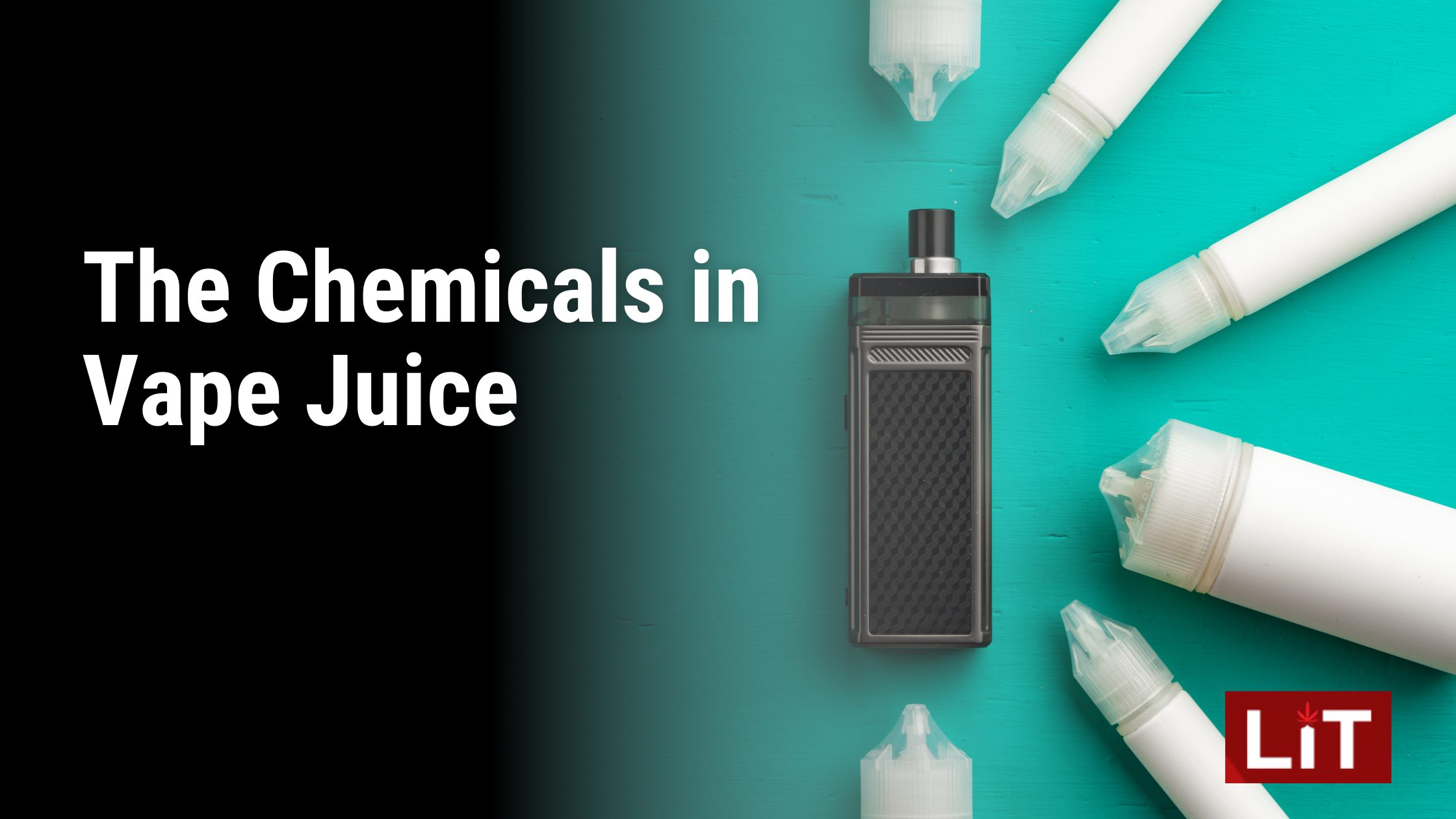
A plethora of potentially harmful chemicals are found in vape juice, including diacetyl, formaldehyde, and acrolein, each posing significant threats to lung health. Diacetyl, an artificial flavoring compound, is associated with a severe respiratory condition known as ‘popcorn lung’ or bronchiolitis obliterans. It’s characterized by persistent cough, shortness of breath, and wheezing. While safe to eat, this chemical becomes harmful when heated and inhaled, making it a significant risk in vape juice.
Formaldehyde, a well-recognized carcinogen, is another dangerous chemical found in vape juice. When e-cigarettes are used at high temperatures, the propylene glycol and glycerin in vape juice can degrade into formaldehyde. The inhalation of formaldehyde poses a substantial risk of developing cancers, particularly in the throat and nasopharynx.
Acrolein, an herbicide primarily used to kill weeds, is another harmful substance in e-cigarette vapor. Prolonged inhalation of acrolein can irritate the nasal passages, throat, and lungs and has been linked to chronic obstructive pulmonary disease (COPD) and asthma.
Moreover, vape juice often contains additional ingredients, such as flavorings and oily bases, which may pose unknown long-term risks to lung health. Despite the popularity of vaping and the perception of it as a safer alternative to smoking, the reality is that the chemicals in vape juice can cause significant harm to the lungs, leading to a range of potentially severe respiratory conditions. Understanding the chemicals in vape juice is essential for grasping the true impact of vaping on lung health.
Perception Vs. Reality of Vaping
Exploring the murky waters of vaping’s perceived safety versus its actual impact reveals a stark discrepancy rooted in misinformation and misconceptions. Vape pens, often touted as a safer alternative to traditional cigarettes, carry significant risks that are frequently overlooked.
This perception of relative safety is fueled by the marketing strategies of vape manufacturers and the absence of the distinctive smell and visible smoke that cigarettes produce. However, the reality is far more complex and considerably less benign. Studies have consistently indicated that vaping can cause lung damage, leading to severe conditions such as popcorn lung and lipoid pneumonia.
The vapor produced by e-cigarettes is not harmless water vapor but a cocktail of potentially harmful chemicals. Diacetyl, a flavoring agent linked to severe respiratory disease; formaldehyde, a known carcinogen; and acrolein, a powerful irritant, are commonly found in e-cigarette aerosols. These substances, among others, can wreak havoc on the lungs, leading to inflammation and respiratory issues.
Moreover, secondhand vapor can also pose risks to lung health despite its less intrusive nature than secondhand smoke. Non-users exposed to e-cigarette aerosols are unwittingly inhaling the same harmful substances.
The Short-Term Effects of Vape Pens on Lungs
Exploring the immediate and short-term effects of vape pens on the lungs reveals a concerning array of symptoms, including coughing, throat irritation, chest pain, and acute lung injury. Despite their popular appeal as a ‘safer’ alternative to traditional smoking, vape pens carry several risks to lung health.
The aerosol produced by these devices contains harmful substances like nicotine, diacetyl, and heavy metals. When inhaled, these substances can cause inflammation, irritation, and increased lung mucus production, leading to respiratory issues and decreased lung function.
In some cases, vaping may even exacerbate existing lung conditions or trigger asthma symptoms. The immediate discomfort experienced during and after vaping is a clear indicator of its negative impact on lung health. Pain or discomfort in the chest, along with a persistent cough, may point to reduced oxygen intake and potential damage to lung tissues.
While the short-term effects are alarming enough, it is also vital to contemplate the potential for acute lung injury. This condition is a severe lung disease that can occur swiftly after exposure to harmful substances, including those found in vape aerosol. Symptoms of acute lung injury include shortness of breath and severe respiratory distress, often requiring medical intervention.
Long-Term Implications of Vaping
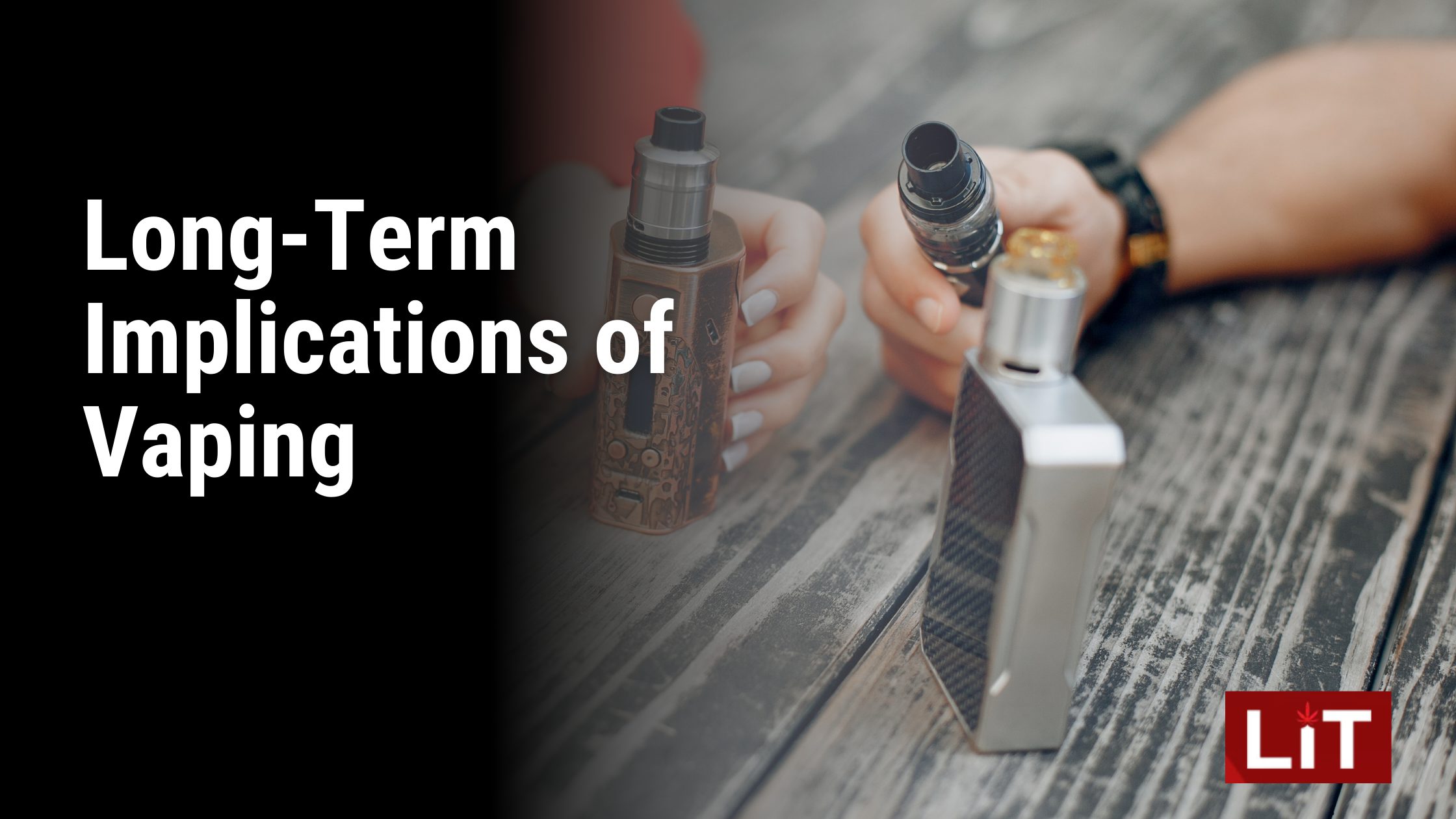
Prolonged use of vape pens harbors a myriad of potential long-term implications, with numerous studies pointing towards significant lung damage and disease. These devices, often touted as a safer alternative to conventional cigarettes, produce vapor-containing harmful substances like nicotine, diacetyl, and heavy metals. When inhaled over a prolonged period, these substances can cause irreversible damage to the lung tissue.
One of the severe lung diseases associated with long-term vaping is bronchiolitis obliterans, also known as popcorn lung. This condition is characterized by the scarring of the tiny air sacs in the lungs, resulting in a persistent cough and shortness of breath. Another notable disease is lipoid pneumonia, a rare condition that occurs when fat particles enter the lungs, causing inflammation and potentially respiratory failure.
The risk of lung cancer may also be heightened with chronic vaping. Although research is still ongoing, it is widely accepted that the inhalation of toxic substances found in vape pens could lead to the development of lung cancer over time.
An acute condition such as pneumothorax or a collapsed lung is a potential complication associated with vaping. This condition can be life-threatening and often requires immediate medical intervention.
Are Vape Pens Bad For Your Lungs?
Given the potential risks and detrimental effects associated with their use, it is imperative to understand why vape pens can indeed be harmful to your lungs. Contrary to the popular belief that vape pens are a safer alternative to traditional cigarettes, they pose significant threats to lung health. The aerosol produced by these devices contains harmful substances such as nicotine, diacetyl, and heavy metals, which can cause irreversible damage to the lungs over time.
Moreover, research indicates that the ultrafine particles present in the e-cigarette aerosol can deeply penetrate the lungs, leading to inflammation and respiratory issues. These particles and toxic substances can irritate and harm lung tissue, impairing its function.
Among the harmful chemicals that vape pens expose the lungs to are diacetyl, formaldehyde, and acrolein. Diacetyl is particularly detrimental as it’s been linked to a severe lung disease known as bronchiolitis obliterans or ‘popcorn lung.’ Other chemicals, such as formaldehyde and acrolein, can cause respiratory issues, including shortness of breath, coughing, and lung inflammation.
The long-term effects of using vape pens are equally concerning. The carcinogens and toxicants present in vape pens can increase the risk of developing lung cancer and other severe respiratory conditions. The use of vape pens can have detrimental effects on lung function and overall respiratory health.
The Link Between Vaping and Lung Disease
Unquestionably, the relationship between vaping and lung disease is increasingly becoming a significant concern in the public health sphere. Vape pens, hailed as a safer alternative to traditional cigarettes, contain harmful substances such as nicotine, heavy metals, and diacetyl. These constituents can cause severe damage to the lungs over prolonged use, leading to lung inflammation and respiratory issues and fostering an environment conducive to lung diseases.
A striking illustration of this is the link between vaping and a severe lung disease named EVALI (E-cigarette or Vaping product use-Associated Lung Injury), which has led to numerous hospitalizations and deaths. Investigations pointed to vitamin E acetate, an additive in THC-containing e-cigarettes, as a possible cause of EVALI. In fact, after the removal of vitamin E acetate from e-cigarette products, cases of EVALI have seen a significant decrease.
Furthermore, diacetyl, a chemical used to flavor e-cigarettes, has been linked to a severe lung condition known as ‘popcorn lung.’ This irreversible disease scars the tiny air sacs in the lungs, leading to the thickening and narrowing of the airways. It’s also worth noting that vaping can sometimes result in severe complications such as lung scarring, breathing difficulties, and, in extreme cases, even collapsed lungs or pneumothorax.
How Vape Pens Affect Lung Tissue
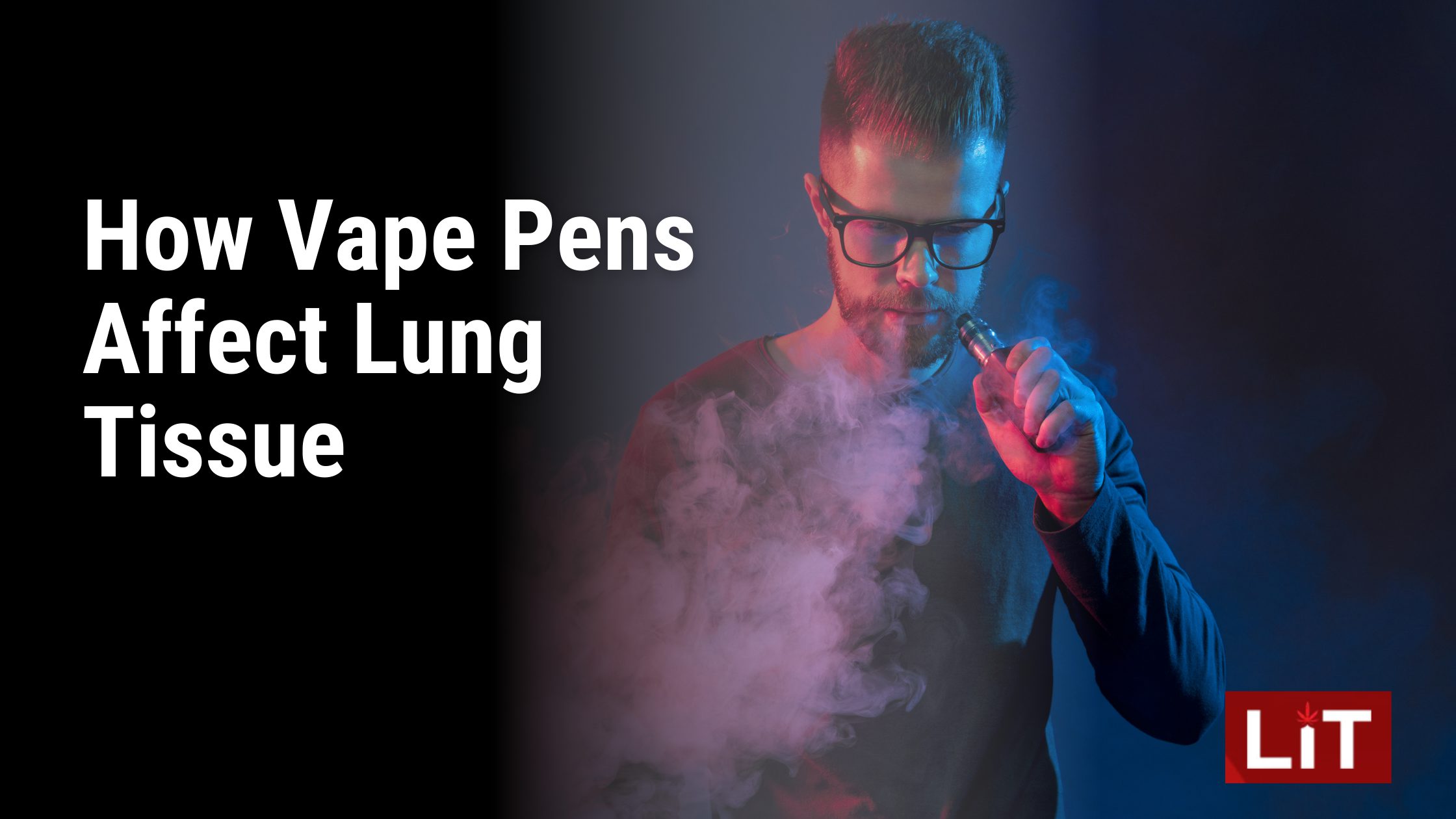
Delving deeper into the effects of vape pens on lung health, it becomes essential to understand how these devices directly impact lung tissue. The vapor produced by these pens contains a cocktail of chemicals that, when inhaled, can trigger inflammation and irritation in the lungs. This is primarily caused by aerosolized nicotine and other harmful substances, such as heavy metals and volatile organic compounds, which are known to cause oxidative stress and damage to lung cells.
Besides causing cellular damage, these chemicals can also trigger immune responses in the lungs. When exposed to the aerosol from vape pens, the lungs initiate an immune reaction to guard against these foreign substances. Unfortunately, this response can lead to respiratory issues, compromising lung function.
Long-term use of vape pens amplifies these effects. Over time, constant exposure to these harmful substances can cause significant damage to the lung tissue, potentially leading to a decrease in lung function and an increased risk of developing lung diseases. Even though vape pens are often promoted as a ‘safer’ alternative to traditional cigarettes, the reality is that their use can still lead to serious respiratory health issues.
Vaping and Chronic Obstructive Pulmonary Disease
Exploring the connection between vaping and Chronic Obstructive Pulmonary Disease (COPD) reveals a disturbing link, with evidence suggesting that the use of vape pens can contribute to the development and exacerbation of this progressive lung disease. Vape pens, despite being marketed as a healthier alternative to conventional cigarettes, contain harmful substances that can cause significant lung damage over time.
The vapors generated by e-cigarettes are laced with potentially hazardous elements such as nicotine, diacetyl, and heavy metals. These substances inflict lung harm, leading to inflammation and other respiratory issues. Consequently, the risk of developing lung diseases like COPD increases.
COPD, a debilitating disease characterized by breathing difficulties, has been associated with the use of vape pens. The chemicals found in these devices can irritate the airways and instigate lung inflammation, thereby exacerbating COPD symptoms. The toxic aerosols emitted by vape pens can cause damage to lung tissues and impair respiratory function, further contributing to COPD.
For individuals already diagnosed with COPD, vaping can have even more devastating effects. Vape pen usage among COPD patients can lead to worsened symptoms and expedite disease progression.
Vape Pens and Asthma
Turning our attention to asthma, it becomes evident that vape pens can exacerbate the symptoms of this respiratory condition due to the harmful chemicals and irritants found in the aerosol. Vape pens produce not harmless water vapor but an aerosol containing toxic chemicals and irritants. Among these are nicotine, a drug known to affect lung function, and diacetyl, a flavoring compound linked to severe lung disease.
For people with asthma, inhaling the aerosol from a vape pen can lead to increased coughing, wheezing, and shortness of breath. Regular use of vape pens can also exacerbate inflammation in the airways, leading to more frequent and severe asthma attacks. The irritants in vape pen aerosol can trigger the inflammation and narrowing of airways characteristic of an asthma attack, making it harder for people living with asthma to breathe.
Moreover, vape pens can lead to other respiratory issues in individuals with asthma. Chronic exposure to the harmful substances in vape pen aerosol can cause damage to the lungs, reducing lung function and capacity over time. This can exacerbate asthma symptoms and increase the risk of developing other respiratory conditions.
E-Cigarettes: A Gateway to Smoking?
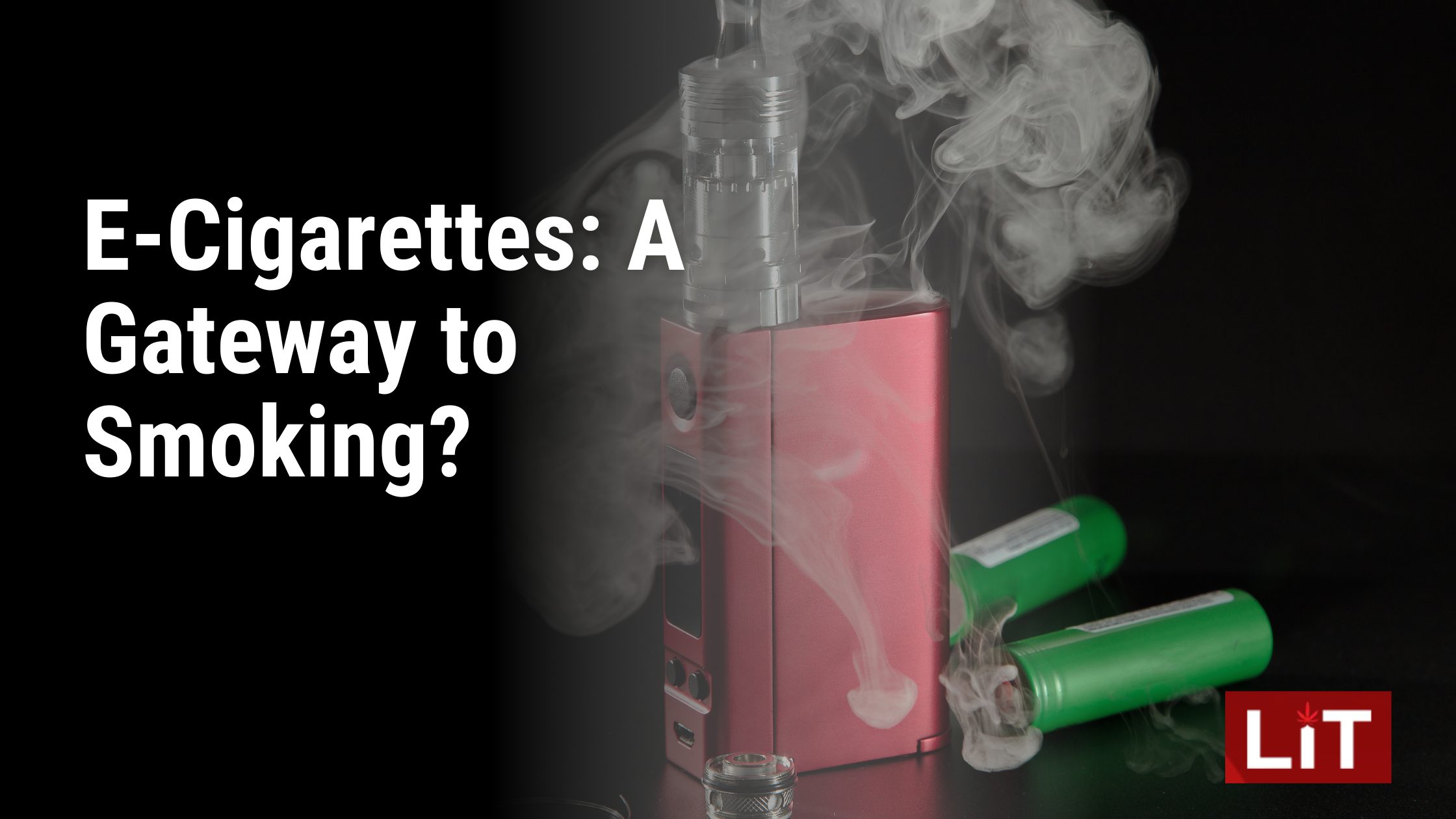
Shifting the focus to the potential role of e-cigarettes as a gateway to traditional smoking, studies indicate that young individuals who use these devices are more likely to start smoking traditional cigarettes eventually. The addictive characteristics of e-cigarettes, primarily due to nicotine, play a significant role, leading the user toward the path of conventional tobacco products.
Research suggests that e-cigarette usage can lead to nicotine addiction, increasing the risk of progressing to combustible tobacco products. This heightened susceptibility is particularly concerning given the well-documented health risks associated with traditional smoking, ranging from lung cancer to heart disease.
Moreover, the marketing strategies employed by e-cigarette companies, especially the use of appealing flavors, are designed to attract youth, potentially initiating a harmful smoking habit. Many young people who succumb to the allure of vaping end up experimenting with cigarettes, which escalates their overall tobacco use. These marketing ploys, along with the misconception that vaping is a less harmful alternative, often lure young individuals into the vicious cycle of nicotine addiction.
Vaping’s Impact on Youth Lung Health
The surge in youth vaping, marked by an alarming doubling of rates, has raised profound concerns about the impact on adolescent lung health. Over 2.1 million young individuals are now embroiled in the use of these e-cigarettes, mainly due to the lack of sufficient education on their hazards, appealing marketing strategies, and the insidious onset of addiction.
Vaping is not an indispensable endeavor for our youth. Contrary to popular belief, the vapor produced by these devices is laden with harmful substances such as nicotine, diacetyl, and heavy metals. These substances can inflict severe damage to the lungs over time, leading to inflammation and respiratory issues. This carries the heavy implication of an increased risk of developing lung diseases.
The addiction risk also poses a significant threat. Nicotine, a primary component in e-cigarettes, is a highly addictive substance. Youth, due to their developing brains, are especially susceptible to its addictive properties. This not only perpetuates the use of e-cigarettes but paves the way for the potential use of traditional cigarettes, further endangering their lung health.
As such, education is a potent tool in the fight against youth vaping. Enhancing awareness about the dangers associated with vaping, as well as providing professional help to those attempting to quit, can go a long way in mitigating this public health concern. In the end, it is vital to remember that the best way to protect lung health, particularly in younger individuals, is to avoid vaping altogether.
The Role of Flavored Vape Juices
Adding to the complexity of the vaping issue is the role of flavored vape juices, which are laden with harmful chemicals and are particularly attractive to younger users. These flavors, ranging from fruit to candy to dessert, mask the harshness of nicotine, making them more appealing and easily consumable. The availability of over 15,000 unique e-liquid flavors further contributes to the allure of vaping, especially for youth.
One of the significant concerns with flavored vape juices is the inclusion of chemicals like diacetyl. Diacetyl, a buttery flavoring agent linked to a severe lung condition called ‘popcorn lung,’ is present in many flavored e-juices. Even though it’s considered safe for ingestion, inhaling it can cause bronchiolitis obliterans, which damages the lung’s tiniest airways and leads to coughing, wheezing, and shortness of breath.
Critics argue that the wide variety of flavored vape juices target and exploit young users, increasing their risk of addiction. Marketing these flavors, often evocative of childhood sweets and treats, is a clear strategy to attract younger users. This is particularly troubling given the evidence linking early nicotine use to long-term addiction.
Vaping, Nicotine Addiction, and Lung Health
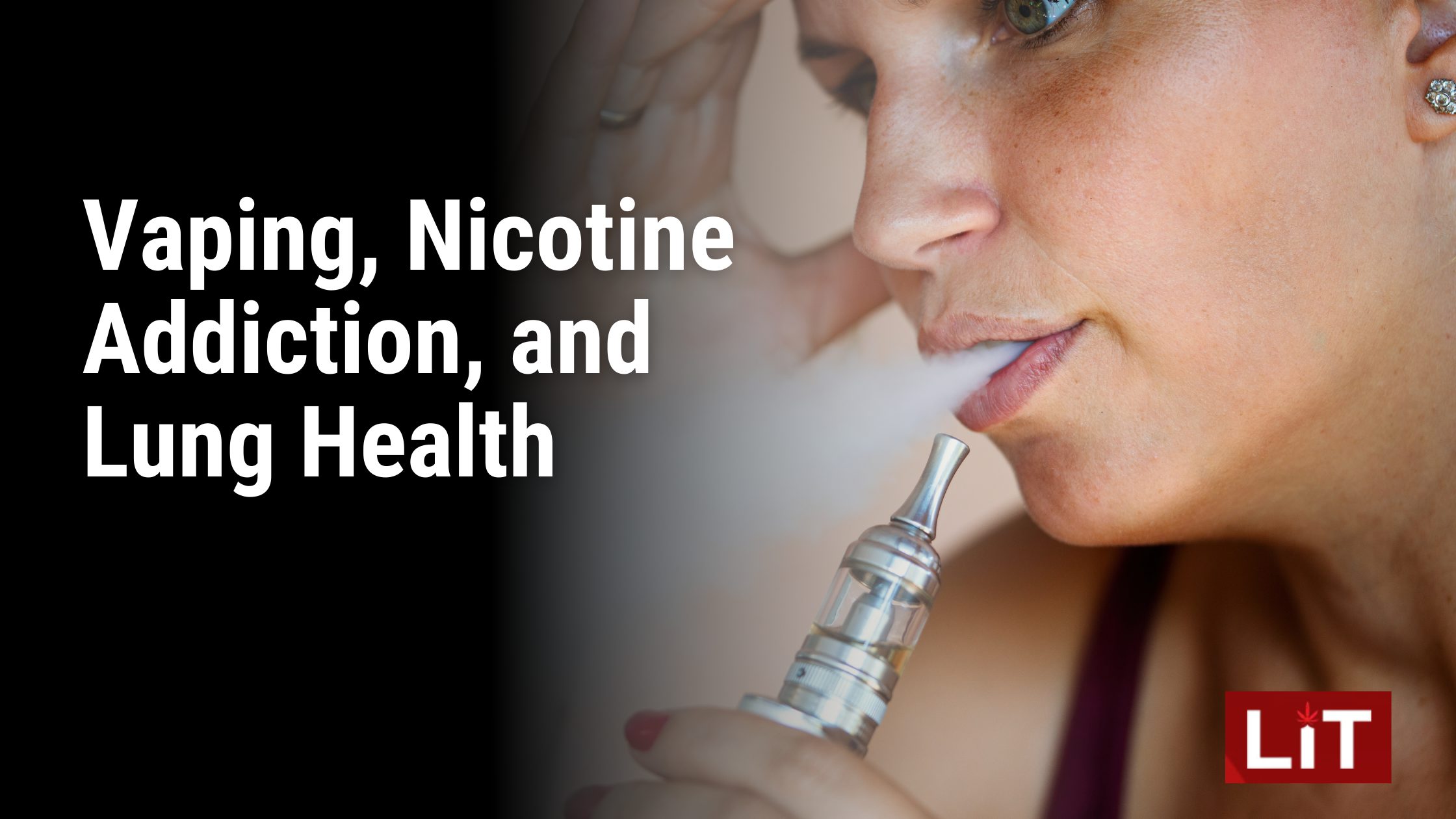
To sum up, the correlation between vaping, nicotine addiction, and lung health in the field of public health is a matter of growing concern. Vape pens, promoted as a safer alternative to traditional cigarettes, harbor significant risks to lung health. They produce a vapor laden with harmful substances such as nicotine, diacetyl, and heavy metals, capable of inflicting damage to the lungs over time.
Research links vaping to lung inflammation and respiratory issues, increasing the risk of developing lung diseases. The idea that vaping is less harmful than smoking is misleading. The harsh reality is that vape pens can negatively impact lung function and overall respiratory health.
Nicotine, a key component in vape pens, is highly addictive. Its effects on the brain’s reward system can lead to addiction, with the potential for profound health implications. Nicotine absorption from vaping can escalate blood pressure and heart rate, posing additional risks to cardiovascular health.
Vaping can also induce a range of lung issues, including throat irritation and cough. Over time, these symptoms could evolve into long-term respiratory diseases. Current research suggests that vaping might be a contributing factor to the development of lung cancer and other grave respiratory conditions.
The risks are amplified for young people. Kids and teens are particularly susceptible to lung damage from vaping due to the impact of nicotine on their developing lungs. To summarize, the relationship between vaping, nicotine addiction, and lung health is complex and warrants further investigation to understand the implications fully.
Vape Pens and Secondhand Vapor
Turning attention to the issue of secondhand vapor, it is essential to highlight that exhaled emissions from vape pens are far from harmless, containing harmful substances like nicotine, diacetyl, ultrafine particles, and benzene. These ultrafine particles can penetrate deep into the lung tissue, causing inflammation and potentially leading to respiratory diseases.
It is a common misconception that vape pens produce harmless water vapor. However, the truth is that the vapor consists of aerosolized particles laden with harmful substances. These particles are small enough to be inhaled by bystanders, allowing toxic substances to enter their lungs. This is particularly concerning for non-smokers who may be exposed to secondhand vapor in public spaces.
Nicotine, a vital component of both traditional cigarettes and vape pens, is a toxic substance that can lead to addiction. It is also harmful to adolescent brain development. Diacetyl, another substance found in e-cigarette vapor, is associated with a severe lung disease known as ‘popcorn lung,’ characterized by the scarring of the tiny air sacs in the lungs, resulting in the thickening and narrowing of the airways.
Moreover, benzene, a carcinogen linked to leukemia and other blood cell disorders, has also been detected in e-cigarette vapor. Although the levels of benzene found in e-cigarette vapor are much lower than those in traditional cigarette smoke, this harmful chemical emphasizes that secondhand vapor is not benign.
The Legal Aspects of Vaping
Exploring the legal landscape of vaping reveals that regulations have been implemented to mitigate the health risks associated with vape pens. The legal age for purchasing these devices is 21 in most states, a measure designed to prevent youth access and the potential early onset of lung-related health issues. This age restriction is a clear recognition of the risks posed by the substances contained in vape pens, such as nicotine, diacetyl, and heavy metals.
Smoke-free laws in many jurisdictions also extend to vaping, with restrictions or even outright prohibitions imposed on vaping in public spaces. This reflects an understanding that the vapor these pens produce, while less visually intrusive than traditional cigarette smoke, can still carry harmful substances and contribute to air pollution.
Further legal measures cover vape pens’ advertising, packaging, and sales. Regulations often stipulate that pens containing nicotine must have appropriate labeling and child-resistant packaging. Such measures alert users to the potential risks and prevent accidental exposure in children.
Debunking Vape Industry Myths

Numerous myths perpetuated by the vape industry obscure the actual health risks associated with vaping. One such myth is the belief that vaping is harmless. On the contrary, credible studies have consistently linked vaping to an array of lung diseases, effectively debunking this misinformation.
The vape industry often touts the absence of harmful by-products found in traditional cigarettes in their products. However, this is far from the truth. Vape pens can expose users to dangerous chemicals such as formaldehyde and acrolein, both of which are recognized as toxic to humans. These substances are present in the aerosol produced by e-cigarettes, presenting a significant hazard to lung health.
Furthermore, the idea that vaping does not cause lung damage is a misrepresentation. Vaping can lead to lung scarring and breathing difficulties, symptoms often associated with severe respiratory conditions. It may even contribute to the development of lung cancer, adding to the list of potential long-term effects of vaping on lung health.
Another myth propagated by the industry is that ‘popcorn lung,’ a condition linked to the chemical diacetyl found in many e-liquids, is not a risk associated with vaping. However, scientific evidence suggests otherwise, confirming that this condition is a natural and present danger for vape users.
Challenging these myths is crucial for public health. It is important to dispel these misconceptions to understand the actual effects of vape pens on lung health and ensure individuals are adequately informed about the risks associated with vaping.
Vaping Vs. Traditional Smoking: a Comparison
In the domain of respiratory health, it is essential to compare and contrast the impacts of traditional smoking and vaping. While both can negatively affect lung health, the key differences lie within the types and quantities of harmful substances each method introduces into the body.
Traditional smoking involves the combustion of tobacco, releasing over 7000 chemicals, including over 70 known carcinogens. These chemicals lead to a myriad of respiratory issues, from chronic bronchitis to lung cancer. Burning tobacco also generates tar, a sticky substance that can coat the lung’s airways, leading to decreased lung function and an increased risk of respiratory infections.
On the other hand, vaping, marketed as a safer option than traditional smoking, still exposes the lungs to harmful substances. Vaping aerosol can contain toxic chemicals such as diacetyl, a flavoring agent linked to a severe lung disease known as bronchiolitis obliterans or ‘popcorn lung.’ Additionally, the aerosol can contain heavy metals and other toxic compounds, leading to lung damage and disease.
Though vaping does not produce the same amount or variety of toxicants as traditional smoking, it is not a risk-free alternative. Both methods contribute to respiratory problems and can potentially lead to serious lung diseases. The degree to which vaping poses less of a risk than traditional smoking is still a subject of ongoing research. It is crucial to approach both cautiously, understanding the potential harm they can inflict on respiratory health.
Scientific Studies on Vaping Effects
A substantial body of scientific literature has emerged, indicating a correlation between vaping and various lung-related health issues. Numerous studies have linked the use of vape pens, otherwise known as e-cigarettes, to lung damage and respiratory complications, contradicting the widespread belief that they are a safer alternative to traditional smoking.
Research conducted by the American Lung Association has revealed that the aerosol produced by vaping devices contains harmful substances such as nicotine, diacetyl, and heavy metals. These chemicals can induce lung inflammation, impair lung function, and potentially cause irreversible damage to lung tissue.
In addition to causing direct harm, vaping has also been associated with an increased risk of developing chronic lung diseases. A study published in The American Journal of Preventive Medicine found that e-cigarette users were notably more likely to be diagnosed with chronic obstructive pulmonary disease (COPD) and other respiratory conditions compared to non-users.
Despite these findings, long-term studies still need to fully elucidate the extent of vaping’s impact on lung health. The existing literature mainly focuses on the immediate and short-term effects of e-cigarette use, with less emphasis on the potential long-term consequences. Nevertheless, the current evidence strongly suggests that the use of vape pens is not without risks and can have severe implications for lung health.
Changing the Conversation About Vaping

To safeguard the public’s health, we must shift the discourse on vaping to shed light on its detrimental effects on lung health. Vaping has been falsely promoted as a safer alternative to traditional cigarettes, leading to a significant increase in its usage, particularly among the youth. However, the brutal truth is that vaping can lead to severe lung conditions such as bronchiolitis obliterans, often referred to as popcorn lung, due to harmful chemicals present in e-liquid.
In addition, inhaling the oily substances from vaping can cause a condition known as vaping-related lipoid pneumonia. This ailment can severely affect lung health, leading to chronic respiratory issues. Furthermore, instances of pneumothorax, a collapsed lung, have been linked to vaping, likely due to potential damage to lung tissue caused by exposure to the harmful substances present in the vapor.
Long-term effects of vaping on lung health can also contribute to the development of lung cancer. This further emphasizes the dire need to change the conversation about vaping and concentrate on its potential health hazards. The public must be aware of these brutal truths to mitigate future harm.
Frequently Asked Questions
How Badly Do Vapes Affect Your Lungs?
Vaping poses significant risks to lung health. While perceived as safer than traditional cigarettes, the vapor from e-cigarettes contains harmful substances such as nicotine, diacetyl, and heavy metals. These substances can damage lung tissue, leading to inflammation, respiratory issues, and an increased risk of lung diseases. Hence, despite the common belief that vaping is less harmful than smoking, it can still significantly impact lung function and overall respiratory health.
Is Vaping Worse Than Cigarettes?
Determining whether vaping is worse than cigarettes remains a complex issue. While both have harmful effects, the overall impact depends on various factors. Cigarettes are known for their carcinogenic properties, leading to lung cancer and other diseases. Meanwhile, vaping exposes users to harmful chemicals potentially causing lung damage. While some argue vaping is less dangerous, it’s important to highlight that both pose significant risks to lung health and overall well-being.
How Bad Is Vaping for Your Health?
As a health hazard, vaping poses profound problems. While touted as a safer substitute for smoking, it undeniably damages lung health. E-cigarette vapor contains harmful substances such as nicotine, diacetyl, and heavy metals that can result in lung inflammation and respiratory issues. Over time, this might lead to serious lung diseases. Therefore, despite its perceived lesser harm compared to traditional cigarettes, vaping indeed has detrimental effects on overall respiratory health.
What Are 10 Dangers of Vaping?
Vaping poses numerous dangers, including lung inflammation, popcorn lung, lipoid pneumonia, and a potential risk of lung cancer. Other risks include respiratory issues, possible lung collapse, and exposure to harmful substances such as nicotine, diacetyl, and heavy metals. Further, chemicals in vaping aerosol, like formaldehyde and acrolein, can cause additional lung damage. Despite perceptions of being safer than traditional cigarettes, the inherent risks of vaping are substantial.
Conclusion
The allure of vaping once considered a ‘less harmful’ smoking alternative, stands debunked. Scientific studies have revealed the presence of harmful substances like nicotine, diacetyl, and heavy metals in e-cigarette vapor. The persistent inhalation of these substances can lead to lung inflammation, respiratory issues, and an increased risk of lung diseases. Just as the myth of the Trojan Horse led to the downfall of Troy, so too, the myth of vaping’s safety may lead to a downfall in public health.
Contact us
Thank you so much for taking the time to read our blog! We hope you found the insights and tips shared useful. To explore more and see what else we have to offer, please visit our main site at Lit Vape Pens.
If you’re interested in our products, don’t miss out on our exclusive collection available at our online shop. And if you’re in the area and want to experience our products first-hand, come visit us! Here’s how to find us: Get directions to our store.
We look forward to welcoming you, both online and in-store!
